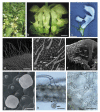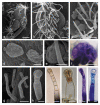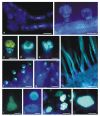Phenolic Constituents of Lamium album L. subsp. album Flowers: Anatomical, Histochemical, and Phytochemical Study
- PMID: 33352709
- PMCID: PMC7766379
- DOI: 10.3390/molecules25246025
Phenolic Constituents of Lamium album L. subsp. album Flowers: Anatomical, Histochemical, and Phytochemical Study
Abstract
Flos Lamii albi has a high biological activity and is widely used in herbal medicine. The aim of the study was to characterize the secretory structures present in Lamium album subsp. album corolla and the location of phenolic compounds. Additionally, we carried out qualitative phytochemical analyses of flavonoids and phenolic acids. Light, fluorescence, and scanning electron microscopy were used to analyze the structure of the floral organs. The main classes of phenolic compounds and their localization were determined histochemically. Phytochemical analyses were performed with high-performance thin-layer chromatography (HPTLC) and high-performance liquid chromatography (HPLC). Six types of glandular trichomes were found which contained flavonoids, phenolic acids, and tannins. The phytochemical studies demonstrated the presence of caffeic, chlorogenic, ferulic, gallic, p-coumaric, protocatechuic, syringic, gentisic, and vanillic phenolic acids as well as rutoside, isoquercetin, and quercetin flavonoids. The corolla in L. album subsp. album has antioxidant properties due to the presence of various polyphenols, as shown by the histo- and phytochemical analyses. The distribution and morphology of trichomes and the content of phenolic compounds in the corolla have taxonomic, pharmacognostic, and practical importance, facilitating the identification of the raw material.
Keywords: flavonoids; phenolic acids; secretory trichomes; tannins; white nettle corolla.
Conflict of interest statement
The authors declare no conflict of interest.
Figures











Similar articles
-
Histochemical and Phytochemical Analysis of Lamium album subsp. album L. Corolla: Essential Oil, Triterpenes, and Iridoids.Molecules. 2021 Jul 8;26(14):4166. doi: 10.3390/molecules26144166. Molecules. 2021. PMID: 34299441 Free PMC article.
-
Lamalbid, Chlorogenic Acid, and Verbascoside as Tools for Standardization of Lamium album Flowers-Development and Validation of HPLC-DAD Method.Molecules. 2020 Apr 9;25(7):1721. doi: 10.3390/molecules25071721. Molecules. 2020. PMID: 32283643 Free PMC article.
-
Nectar guides and floral nectary in Lamium album L. subsp. album: structure and histochemistry in light, fluorescence, and electron microscopy.Micron. 2023 Aug;171:103474. doi: 10.1016/j.micron.2023.103474. Epub 2023 Apr 29. Micron. 2023. PMID: 37156083
-
Therapeutic Potential of Phenolic Compounds in Medicinal Plants-Natural Health Products for Human Health.Molecules. 2023 Feb 15;28(4):1845. doi: 10.3390/molecules28041845. Molecules. 2023. PMID: 36838831 Free PMC article. Review.
-
Representative literature on the phytonutrients category: Phenolic acids.Crit Rev Food Sci Nutr. 2017 Apr 13;57(6):1089-1096. doi: 10.1080/10408398.2013.865589. Crit Rev Food Sci Nutr. 2017. PMID: 25831057 Review.
Cited by
-
Phenolic Compounds in Flowers and Herb of Achillea millefolium L.: Histochemical and Phytochemical Studies.Molecules. 2025 May 7;30(9):2084. doi: 10.3390/molecules30092084. Molecules. 2025. PMID: 40363889 Free PMC article.
-
Application of Lamium album Leaves Powder in Wheat Bread Technology.Plant Foods Hum Nutr. 2025 Apr 7;80(2):106. doi: 10.1007/s11130-025-01328-5. Plant Foods Hum Nutr. 2025. PMID: 40192867
-
Use of Secondary Metabolites Profiling and Antioxidant Activity to Unravel the Differences between Two Species of Nettle.Plants (Basel). 2023 Sep 11;12(18):3233. doi: 10.3390/plants12183233. Plants (Basel). 2023. PMID: 37765397 Free PMC article.
-
Histochemical and Phytochemical Analysis of Lamium album subsp. album L. Corolla: Essential Oil, Triterpenes, and Iridoids.Molecules. 2021 Jul 8;26(14):4166. doi: 10.3390/molecules26144166. Molecules. 2021. PMID: 34299441 Free PMC article.
-
Anatomical and Trait Analyses Reveal a Silicon-Carbon Trade-Off in the Epidermis of Sedges.Plant Cell Environ. 2025 Mar;48(3):2396-2410. doi: 10.1111/pce.15307. Epub 2024 Nov 28. Plant Cell Environ. 2025. PMID: 39610186 Free PMC article.
References
-
- Mabberley D.J. The Plant Book. 2nd ed. Cambridge University Press; Cambridge, UK: 1997.
-
- Yordanova Z.P., Zhiponova M.K., Iakimova E.T., Dimitrova M.A., Kapchina-Toteva V.M. Revealing the reviving secret of the white dead nettle (Lamium album L.) Phytochem. Rev. 2014;13:375–389. doi: 10.1007/s11101-014-9356-2. - DOI
-
- Dengler J., Berg C., Eisenberg M., Isermann M., Jansen F., Koska I., Löbel S., Manthey M., Pazolt J., Spangenberg A., et al. New descriptions and typifications of syntaxa within the project ‘Plant communities of Mecklenburg-Vorpommern and their vulnerability’—Part I. Feddes Repertorium Zeitschrift für Botanische Taxonomie und Geobotanik. 2003;114:587–631. doi: 10.1002/fedr.200311017. - DOI
-
- Metcalfe C.R., Chalk L. Anatomy of the Dicotyledons. Volume 2 Oxford Press; London, UK: 1972.
-
- Sulborska A., Dmitruk M., Konarska A., Weryszko-Chmielewska E. Adaptations of Lamium album L. flowers to pollination by Apoidea. Acta Sci. Pol. Hortorum Cultus. 2014;13:31–43.
MeSH terms
Substances
LinkOut - more resources
Full Text Sources

